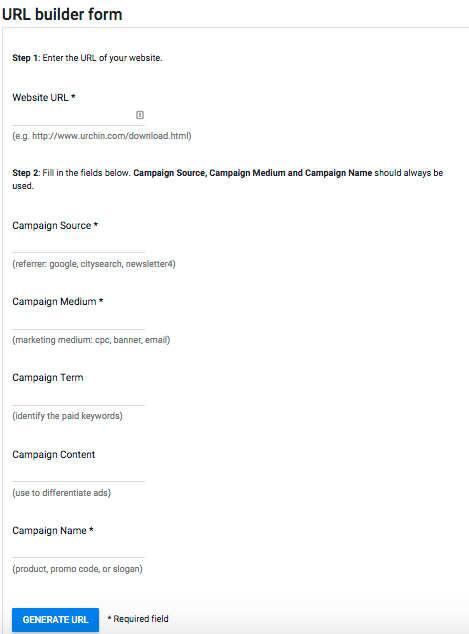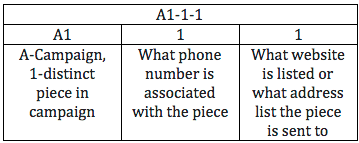Basic Tips and Tricks Every Business and Marketer Can Use to Prove The Source of Campaign ROI
Whether or not your business is advertising, you’re always marketing. Every phone call, mailer, coupon, Facebook post, email… everything is a representation of your brand. Knowing what marketing piece works and especially what doesn’t, reveals what steps to take in the future. Numbers don’t lie. The analytical success and failures of your pieces cannot be ignored. In order to hone your marketing efforts, tracking, both print and digital, is no longer an option, it’s a mandatory, tedious process, but like everything, there are tricks to marketing campaign tracking.

Track Everything
Your marketing pieces aren’t just advertising, they’re raw data!
Phone Calls, emails, web banners, social media posts, mail pieces, billboards, TV commercials, radio spots -- every campaign can, and should, be monitored to the most extreme level. You need to gather every minute piece of data from every advertising piece, and while it can get complicated there are easy steps to start the process.
Understanding your campaign’s reach is important, but understanding what specific components among your reach are working...that’s how your campaigns success will skyrocket.
Use custom URLs for Every Web Piece
Create custom urls through Google and use Google Analytics to truly own your web presence.
Using Google’s free URL builder you can easily create custom URLs for every web campaign, email campaign and social media post. But why? Well, the answer here is simple: Google Analytics. Google Analytics allows users to track and understand where their web traffic is coming from. With the capacity to set goals, and determine who is visiting what site, down to distinct demographics, Google Analytics shows you what your web presence is. Getting your web presence to what you want it to be, well, that’s up to you.
Still, the first step to improving your web reach is identifying what it currently is. By placing custom URLs on email blasts, guest blogs, social media posts and however else you advertise on the web, you’ll be able to see what posts are leading users to click on your website’s page. Finding where your clicks are coming from is great. Finding what posts are ineffective is even better! You’ll be able to cater your efforts, and time, into what’s working.
Do you know how many leads you’re getting from Facebook? How many from the pricey Google PPCs your client is sold on? When used correctly, Google analytics is detailed. It can show how many users got to your company’s site from Facebook, and distinguish between mobile and laptop.
Google uses distinct UTM parameters, which you will fill in. They distinguish between different campaigns and different lead sources within campaigns. When building a custom link there are a variety of these fields:

Each link you create should lead users to the same campaign page, whichever site you’re promoting. These fields, or UTM parameters within the custom links, are what allow Google Analytics to evaluate where your viewers are coming from.
Which source, like google or Facebook, are they clicking on? What form of, email marketing or a web banners, led to each click? Which terms are key in this ad? And most importantly, are you testing two versions of this ad within your campaign? And what are their results?
Phone Keeps Ringing, We Keep Tracking
What drove a consumer to call your business? Which piece caught their eye?
No matter your business, chances are your marketing pieces, both digital and print, highlight a call-to-action. When that call-to-action is a literal phone call, it is important to know which marketing piece drew your potential customer in.
Placing distinct phone numbers on every piece is the best way to distinguish, which ads hit or miss. Thanks to the web, and a multitude of options, purchasing a unique call-tracking number is easy. Sites like Convierza (formerly LogMyCalls) and Grasshopper offer 800 numbers and call tracking analysis all in one place.
We recommend sending out different versions of your ads, each with its own distinct phone number, and seeing which one works and which do not. From here, the next step is simple, keep using what works and recycle your purchased number for a different campaign. Continue to flood your market with pieces, knowing that you’ll be able to identify the phone call you receive, whether they become a customer or not, to better adjust your marketing efforts, and in time raise your marketing ROI.
Sending out a bunch of flyers with your company’s logo, hours, information, and a distinct tracking number is great. Sending out a bunch of flyers with the previously stated info and its own tracking number, well, that’s the best means of identifying which print pieces are hitting their mark and which pieces were a waste of ink.
Create a list-segmentation system to track all of your direct mail pieces, and note which corresponding 800-number goes with each piece, and distinct web URL (more to come on this soon!) Be sure to cater your tracking methods so that you can best analyze them. We recommend a basic identification process. Consider, a code like: A1-1-1.

The “A” signifies which campaign the piece is from, while the first “1” is to distinguish it from other designs in the same campaign. The next “1” is the unique phone number associated with the piece, and the final “1” is to identify the web address associated with it. So with this code, both A1-1-1 and A2-2-1, are from the same campaign, but are different pieces, each using their own phone numbers.
Doesn’t Have to be Digital
Tracking codes and digital analytics are necessary for print pieces too!
When designing the mailer find the most non-intrusive amount of real estate, the white space in the bottom right corner for example. Here is where you place your custom tracking information.
The next step is simple, but certainly the most imposing, make sure you find out which mail piece drew in your potential sales and record everything! This process is easier with coupons, where the customer will most likely bring the coupon to your storefront and you can visibly see the code. When this is not the case, don’t be afraid to ask! Have examples ready so that you can, hopefully smoothly, identify which flyer attracted this customer to your shop.
Using tracking codes on mail pieces has a multitude of other factors that affect the results, but by tracking, recording and analyzing you can certainly reduce future risks. Sending out direct mail, for example, has the added risk of determining which list of potential recipients is best for you, and the cost of postage. Through iterations, implementing codes and analysis you’ll be better set to determine which messages to send and to what list of addresses.
Don’t be Shy
If you don’t know how someone found out about you, ask them!
Whether or not you’re tracking everything to the best of your ability, studying the analytics day and night, and making the proper adjustments, data will fall through the cracks. Sometimes a customer might wander to your store or site purely by chance, and that’s okay! What’s not okay is letting this person leave without attempting to identify how they found out about you. Your greatest tool here is yourself. Be kind and ask.
You’ll notice more and more businesses are asking how you, the customer, have heard of them. They want to know who their clientele is, in order to cater strategies to better reach out to them. There is no harm in asking, and there’s a great benefit in recording.
Iterations, Analytics, More Iterations
Your marketing efforts need to be tracked and analyzed with each iteration in order to see the best results possible.
Marketing, to me, isn’t a circle, where you send out a mob of materials, online and print, track, analyze and repeat. Instead, marketing is a spiral, and hopefully its spiraling in and not out. In this spiral-scenario you send out your marketing materials (all of which have tracking numbers, websites and phone numbers), track the results, analyze, and use this new information to re-adjust your plan. This re-adjustment should, ideally, change the course of your scheme and instead of simply repeating the process, you’ll move closer to a higher ROI. That’s the ultimate goal with marketing, a greater ROI, and the best means of doing so is to track EVERYTHING and adjust accordingly.
Tracking results can be tiring, and there are endless amounts of tools to help you. What works for some may not work for all. While you’re marketing may be effective, if you’re not recording your results, especially what pieces are failing, you’re missing out on opportunities to grow.

Thanks to
Josh Gershonowicz for sharing their advice and opinions in this post. Josh Gershonowicz is the founder and CEO of
Rebuild Nation, a marketing firm which focuses on the dental and health industry. You can follow him on
Twitter or connect on
LinkedIn.





 Thanks to
Thanks to 


